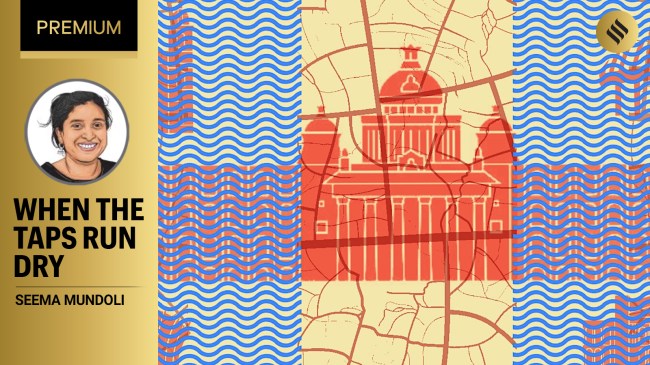Opinion What happens when Bengaluru’s taps run dry?
To reimagine the city's waterscape, it is essential to rebuild our lost relationship with the many meanings of water
 The India Meteorological Department had said that the 2023 monsoon had been below normal owing to the El Nino impact, contributing to the current water crisis. (Illustration by CR Sasikumar)
The India Meteorological Department had said that the 2023 monsoon had been below normal owing to the El Nino impact, contributing to the current water crisis. (Illustration by CR Sasikumar) Newspaper headlines on the water crisis Bengaluru has been experiencing read like the pages of an apocalyptic thriller. People leaving the city for their hometowns as the taps have run dry; residents of apartments lining up to use toilet facilities in malls; bone-dry borewells; unaffordable rates charged by water tankers. Adding to the panic are the circulars issued with the threat of fines if potable water is used in swimming pools, for watering plants and washing cars, and legal consequences for drilling private borewells.
The India Meteorological Department had said that the 2023 monsoon had been below normal owing to the El Nino impact, contributing to the current water crisis. Forecasts predict that the monsoon, when it arrives, could be normal. But as we have seen in previous years, this could also mean just more bad news — waterlogging and flooding causing chaos and panic again.
We can no longer ask the question: What is wrong with the climate of Bengaluru? It is time to ask ourselves — what is wrong with us when it comes to imagining the waterscape of this metropolitan city? Perhaps this is a good time to reflect on three Rs — our relationship, our rights, and our responsibilities—when it comes to water in Bengaluru.
Bengaluru was once known as Kalyana Nagara or the City of Lakes. These lakes or keres were carved out of depressions in the landscape by human ingenuity and hard labour, and rainwater was directed into these depressions via rajakaluves (channels). Lakes were constructed in a series, with overflow from upstream lakes flowing into the lakes downstream, with the wetlands around the lakes helping groundwater recharge. In proximity to the lakes were several smaller water bodies, for example, kalyanis (temple ponds), baavis (wells/stepwells), and gokattes (ponds for washing cattle). The lakes supported livelihoods such as grazing and fodder collection, fishing, and agriculture. Nagarkallus (snake stones) and shrines on the lake bund were worshipped by the local communities. Children and adults spent afternoons swimming in these lakes, while women foraged for greens that they included in the family meals. Thus, the lakes were central to the economic, cultural, and social lives of the local community.
But this almost idyllic waterscape that supported different kinds of use and was of immense ecological significance has undergone massive changes. Beginning in colonial times, many of these water sources were converted to different kinds of land use, a practice which continued after Independence. Thus, lakes became bus stands and stadiums. Ponds were filled for building homes. Wells fell to disuse. The transformation of the city into India’s software capital, beginning in the 1990s, came at an especially huge cost. Buildings have come up where once wetlands were located, and the area covered by lakes has also reduced. The channels that enabled the flow of water between upstream and downstream lakes were encroached or filled up. The few remaining lakes, which were once seasonal, have become perennial — perennially filled with sewage water and garbage dumped from homes, hospitals, and business establishments.
As the city urbanised, the need for water increased — but the supply was marked by inequity. The affluent layouts and apartment complexes in the city’s core were connected through the municipal piped water system. In the peripheral areas that did not have access to municipal water, the water tankers filled the gap. At the same time, both in the centre of the city and the periphery, the slums and layouts where the poor lived struggled to get sufficient water even for basic needs such as drinking, cooking and sanitation. Thus, the right to water, a fundamental human right, has been denied to a large population of urban poor.
Meanwhile, it is the mandate of the government to provide safe and sufficient water to all. With the local water bodies lost to a rapidly urbanising Bengaluru, water for the city has been brought in from the Cauvery river more than a hundred kilometres away. Supplementing this is water from the Arkavathy river, and water pumped from government owned borewells. Laws, guidelines, and schemes related to rainwater harvesting, sinking private borewells and treatment of sewage water have been introduced over the years with the objective of conserving water. The responsibility of the government and the citizens when it comes to water is thus laid out, to some extent. However, the failure in dealing with the responsibility is evident in the extreme water scarcity Bengaluru is facing today.
It is time for the city and its residents to reflect on the three Rs.
First, reworking our relationship with water. This will require that the city and its residents reconnect with water in ways the generations earlier did — making the remnant lakes, ponds, and wells central to the social and cultural lives of the city, and wherever possible also to support the livelihoods of those who continue to depend on these water bodies, such as fishers, grazers, and foragers. Second, addressing the inequity in access to water. We cannot have a section of the city’s population using water to fill their swimming pools while another section, a considerable majority at that, struggles to get safe and sufficient water even for their basic needs. Water is a shared resource, a right of every resident of the city — not just of the affluent. Third, if water is a right, then each of us needs to be responsible for its sustainable use. The city and its residents need to be conscious of where every drop of water comes from, how and how much water is used, how much can be recycled and what is the best use of sewage water.
Today, Bengaluru’s association with water seems to be caught in an endless cycle of dealing with scarcity and flooding. There is water scarcity now. Once the monsoon starts, the fear of flooding will grip the city. Bengaluru needs to move away from this continuous negative, and stress-inducing, association with water by committing to the three Rs— building our lost relationship with the many meanings of water; ensuring equal right to water for all; and being responsible for every single drop of water we use.
The writer is faculty at Azim Premji University




